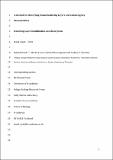Files in this item
A method for identifying Sound Scattering Layers and extracting key characteristics
Item metadata
| dc.contributor.author | Proud, Roland | |
| dc.contributor.author | Cox, Martin James | |
| dc.contributor.author | Wotherspoon, S. | |
| dc.contributor.author | Brierley, Andrew Stuart | |
| dc.date.accessioned | 2016-05-14T23:32:13Z | |
| dc.date.available | 2016-05-14T23:32:13Z | |
| dc.date.issued | 2015-10 | |
| dc.identifier.citation | Proud , R , Cox , M J , Wotherspoon , S & Brierley , A S 2015 , ' A method for identifying Sound Scattering Layers and extracting key characteristics ' , Methods in Ecology and Evolution , vol. 6 , no. 10 , pp. 1190-1198 . https://doi.org/10.1111/2041-210X.12396 | en |
| dc.identifier.issn | 2041-210X | |
| dc.identifier.other | PURE: 195619230 | |
| dc.identifier.other | PURE UUID: a7562db0-fc7b-42ce-8ddf-50288bfbeeb0 | |
| dc.identifier.other | Scopus: 84944156295 | |
| dc.identifier.other | ORCID: /0000-0002-8647-5562/work/35710930 | |
| dc.identifier.other | ORCID: /0000-0002-6438-6892/work/60427338 | |
| dc.identifier.other | WOS: 000362916000008 | |
| dc.identifier.uri | https://hdl.handle.net/10023/8801 | |
| dc.description.abstract | Mid-trophic level water-column (pelagic) marine communities comprise millions of tonnes of zooplankton and micronekton that form dense and geographically extensive layers, known as sound scattering layers (SSLs) when observed acoustically. SSLs are ubiquitous in the global ocean, and individual layers can span entire ocean basins. Many SSLs exhibit clear diel vertical migration behaviour. Vertical migrations contribute substantially to the 'biological pump', such that SSLs have important global biogeochemical roles: SSLs are important conduits for vertical energy and nutrient flow. Ship-based remote sensing of SSLs using acoustic instruments (echosounders) enables their shape and density to be quantified, but despite SSLs being discovered in the 1940s, there is no consistent method for identifying or characterising SSLs. This hampers ecological and biogeographical studies of SSLs. We have developed an automated and reproducible method for SSL identification and characterisation, the sound scattering layer extraction method (SSLEM). It functions independently of echosounder frequency and the spatial scale (vertical and horizontal) of the data. Here we demonstrate the SSLEM through its application to identify SSLs in data gathered to a depth of 1000 m using 38 kHz hull-mounted echosounders in the south-west Indian Ocean and Tasman Sea. SSLs were identified in the water column as horizontally extensive echoes that were above background noise. For each identified SSL, a set of 9 quantitative 'SSL metrics' (describing their shape, dynamics and acoustic backscattering distribution) were determined, enabling inferences to be made concerning the spatial arrangement, distribution and heterogeneity of the biological community. The method was validated by comparing its output to a set of visually derived SSL metrics that were evaluated independently by 8 students. The SSLEM outperformed the by-eye analysis, identifying three times the number of SSLs and with greater validity; 95% of SSLs identified by the SSLEM were deemed valid, compared to 75% by the students. In the same way that data obtained from satellites have enabled the study and characterisation of global phytoplankton distribution and production, we envisage that the SSLEM will facilitate robust, repeatable and quantitative analysis of the growing body of SSL observations arising from underway-acoustic observations, enhancing our understanding of global ocean function. | |
| dc.language.iso | eng | |
| dc.relation.ispartof | Methods in Ecology and Evolution | en |
| dc.rights | © 2015 The Authors. Methods in Ecology and Evolution © 2015 British Ecological Society. This work is made available online in accordance with the publisher’s policies. This is the author created, accepted version manuscript following peer review and may differ slightly from the final published version. The final published version of this work is available at https://dx.doi.org/10.1111/2041-210X.12396. This article may be used for non-commercial purposes in accordance with Wiley Terms and Conditions for Self-Archiving (http://olabout.wiley.com/WileyCDA/Section/id-820227.html#terms). | en |
| dc.subject | Biological communities | en |
| dc.subject | Biological layers | en |
| dc.subject | Deep scattering layers | en |
| dc.subject | Diel Vertical Migration | en |
| dc.subject | Marine acoustics | en |
| dc.subject | Mid-trophic level | en |
| dc.subject | Pelagic ecology | en |
| dc.subject | Sound scattering layer extraction method | en |
| dc.subject | SSL metrics | en |
| dc.subject | QH301 Biology | en |
| dc.subject | SDG 14 - Life Below Water | en |
| dc.subject.lcc | QH301 | en |
| dc.title | A method for identifying Sound Scattering Layers and extracting key characteristics | en |
| dc.type | Journal article | en |
| dc.description.version | Postprint | en |
| dc.contributor.institution | University of St Andrews. School of Biology | en |
| dc.contributor.institution | University of St Andrews. Marine Alliance for Science & Technology Scotland | en |
| dc.contributor.institution | University of St Andrews. Scottish Oceans Institute | en |
| dc.contributor.institution | University of St Andrews. Centre for Research into Ecological & Environmental Modelling | en |
| dc.contributor.institution | University of St Andrews. Pelagic Ecology Research Group | en |
| dc.identifier.doi | https://doi.org/10.1111/2041-210X.12396 | |
| dc.description.status | Peer reviewed | en |
| dc.date.embargoedUntil | 2016-05-15 |
This item appears in the following Collection(s)
Items in the St Andrews Research Repository are protected by copyright, with all rights reserved, unless otherwise indicated.

